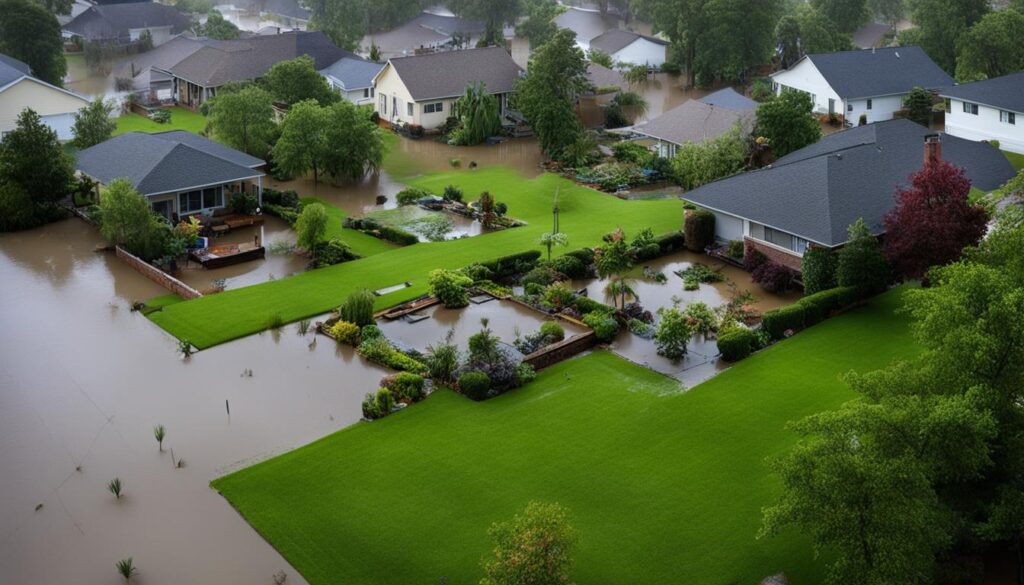Welcome to the first section of our guide on how to combat flood in your backyard and prevent water damage to safeguard your property. A flooded backyard can lead to significant damage and pose a threat to the structural integrity of your home. By taking proactive measures and implementing proper landscaping techniques, you can minimize the risk of flooding and protect your investment.
In this section, we will explore various methods to prevent flood in your backyard, including leveling a sloping yard, choosing local plants, using mulch, planting new grass, creating a rain garden, and adding drainage areas near driveways. These strategies will help you mitigate the impact of heavy rainfall and ensure that water does not seep into your home, causing costly damage.
Stay tuned for detailed information on each technique in the subsequent sections of this article. Whether you have experienced backyard flooding in the past or want to take preventive measures, this guide will equip you with the knowledge and tools necessary to protect your property from water damage. Let’s dive in and discover the best ways to combat flood and safeguard your backyard!
Landscaping To Prevent Flooding In Your Home
Proper landscaping techniques can significantly reduce the risk of flooding in your backyard, preventing water from leaching through the foundation into your home.
Leveling a sloping yard away from your house helps in directing the flow of melting snow and rainwater away from your home and basement. This prevents water from accumulating near your foundation, which can lead to flooding.
Choosing local plants native to your area can not only beautify your yard but also prevent soil erosion. These plants have adapted to the local climate and soil conditions, making them more resistant to flooding and helping with efficient rainwater drainage.
Using mulch in garden areas graded away from your home can help hold rainwater, allowing it to soak into the soil gradually, instead of flowing toward your home. This reduces the risk of water pooling near your foundation and causing flooding.
Planting new grass with a robust root structure can absorb the excess water during heavy rainfall and reduce the impact of floods. The roots act as natural sponges, effectively soaking up the water and preventing it from entering your home.
Creating a rain garden is another effective landscaping technique to prevent flooding. Rain gardens are shallow depressions in your yard that capture and absorb rainwater, allowing it to slowly percolate into the ground. This helps to prevent water from pooling in your yard and flooding your home.
Adding drainage areas near driveways can also minimize flooding risks. These areas can redirect excess water away from your home, ensuring proper water flow and preventing flooding caused by water accumulation.
Why Do Yards Flood? And How To Stop It?
Yards can flood due to two main reasons: extreme weather conditions and insufficient or broken drainage infrastructure. Heavy rainfall, hurricanes, and downpours can lead to flooding in yards, causing damage to your property. Inadequate drainage systems and poor infrastructure can also contribute to flooding, exacerbating the problem.
Understanding the reasons behind yard flooding is crucial in preventing it from happening in the future. By taking necessary steps and implementing effective measures, you can protect your yard from flooding and minimize the risk of water damage. Here are some steps you can take:
Ensure Proper Drainage Infrastructure
Inspect your existing drainage system and make sure it is functioning optimally. If you find any issues or blockages, address them promptly. Consider installing additional drainage systems if needed to improve water flow and prevent water accumulation.
Regrade Your Yard
One effective way to prevent yard flooding is to regrade your yard and create a slope away from your house. This will help redirect rainwater and prevent it from pooling near your foundation, reducing the risk of water seeping into your home. Consult with a professional if you are unsure about the proper slope and grading techniques.
Install Dry Wells
Dry wells can collect and release excess water, preventing it from pooling in your yard. By installing dry wells strategically, you can improve drainage and minimize the risk of flooding. Consider the location and capacity of the dry wells based on the size of your yard and the amount of rainfall you typically experience.
Plant a Rain Garden
A rain garden is a specially designed garden that helps absorb rainwater and prevents it from running off into surrounding areas. By planting native vegetation in your rain garden, you can help restore the natural water cycle and reduce the risk of yard flooding. Choose plants that thrive in wet environments and have deep root systems to enhance water absorption.
Invest in Sump Pumps
Sump pumps can be a valuable addition to your yard’s flood prevention measures. These pumps are designed to quickly remove excess water from your yard, preventing flooding and minimizing water damage. Consult with a professional to determine the right type and capacity of sump pump for your yard.
By understanding why yards flood and implementing these preventive measures, you can effectively stop yards from flooding and safeguard your property from water damage.
Backyard Flooding Solutions to Control Stormwater Runoff
Controlling stormwater runoff is essential to prevent backyard flooding and protect the environment. There are several effective solutions you can implement to control stormwater and minimize the risk of flooding in your backyard.
1. Swales: Swales are shallow, vegetated channels that redirect water drainage away from your property. By strategically positioning swales in your backyard, you can help direct the flow of stormwater runoff away from vulnerable areas.
2. Rain Gardens: Rain gardens are specially designed areas in your yard that collect and absorb rainwater. They provide a natural space for water to pool and slowly percolate back into the soil. By incorporating rain gardens into your landscaping, you can effectively manage stormwater runoff and prevent backyard flooding.
3. Heavier Mulch: Using heavier mulch in your garden areas can help prevent flooding and clogging of drains. The extra weight of the mulch helps to hold rainwater in place, allowing it to slowly infiltrate into the ground rather than running off.
4. Diverting Rain Spouts: By redirecting your rain spouts away from your home and towards areas where water can safely drain, you can help minimize stormwater runoff and reduce the risk of backyard flooding. Consider directing the water towards a rain garden or permeable surface.
5. Replacing Impervious Surfaces: If you have impervious surfaces such as concrete or asphalt in your backyard, they can contribute to increased stormwater runoff. Consider replacing these surfaces with alternatives like green roofs or permeable materials that allow water to infiltrate into the ground.
By implementing these backyard flooding solutions, you can effectively control stormwater runoff and protect your property from the negative effects of flooding. These approaches not only safeguard your home but also contribute to the overall reduction of stormwater runoff and its impact on the environment.
Can Installing a French Drain Help Prevent Flooding in the Yard?
Installing a French drain yard effectively can significantly help prevent flooding in the yard. This drainage system collects and redirects excess water away from the property, reducing the risk of water pooling and causing water damage. Properly installed, a French drain can effectively protect your yard from flooding.
Conclusion
Preventing backyard flooding through proper landscaping techniques and stormwater management is essential to safeguarding your property and the environment. By implementing strategies like regrading the yard, installing dry wells, and using rain gardens, you can effectively control stormwater runoff and minimize the risk of flooding.
Regrading your yard to create a slope away from your house helps redirect the flow of excess water, preventing it from seeping into your home. Dry wells are designed to collect and release excess water, reducing the chances of backyard flooding. Rain gardens provide a natural water retention space, allowing water to be absorbed by the soil and preventing it from accumulating in your yard.
In addition to these landscaping techniques, using heavier mulch in your garden areas, diverting rain spouts away from your property, and replacing impervious surfaces with green roofs or permeable materials can further contribute to flood prevention efforts. These methods help control stormwater runoff and ensure that water is effectively managed to prevent backyard flooding.
By taking proactive steps to prevent backyard flooding, you are not only protecting your property but also contributing to a healthier environment. Implementing these landscaping techniques and stormwater management strategies aids in reducing water resource pollution caused by urban stormwater runoff. So, embrace these solutions and create a safer, drier, and more sustainable backyard.











